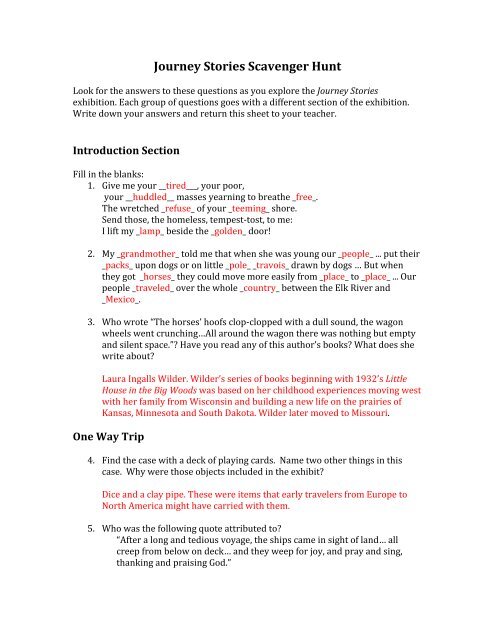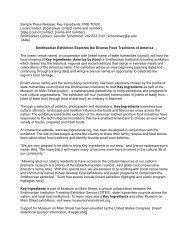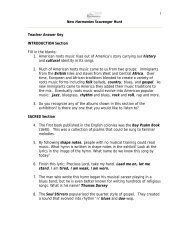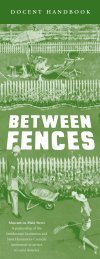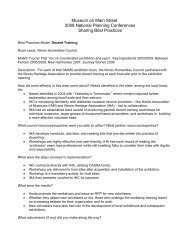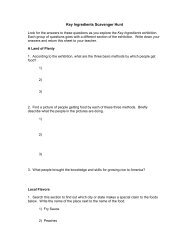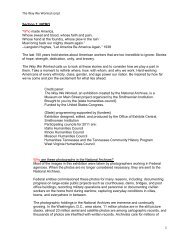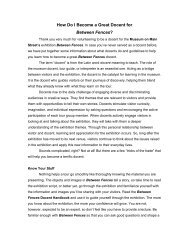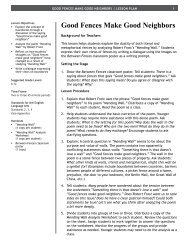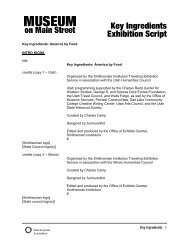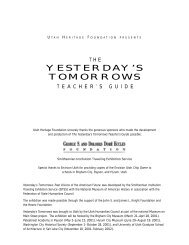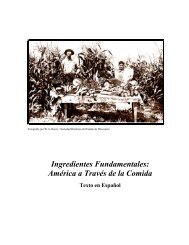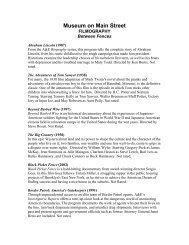Scavenger hunt answer key - Museum on Main Street
Scavenger hunt answer key - Museum on Main Street
Scavenger hunt answer key - Museum on Main Street
- No tags were found...
Create successful ePaper yourself
Turn your PDF publications into a flip-book with our unique Google optimized e-Paper software.
Journey Stories <str<strong>on</strong>g>Scavenger</str<strong>on</strong>g> HuntLook for the <str<strong>on</strong>g>answer</str<strong>on</strong>g>s to these questi<strong>on</strong>s as you explore the Journey Storiesexhibiti<strong>on</strong>. Each group of questi<strong>on</strong>s goes with a different secti<strong>on</strong> of the exhibiti<strong>on</strong>.Write down your <str<strong>on</strong>g>answer</str<strong>on</strong>g>s and return this sheet to your teacher.Introducti<strong>on</strong> Secti<strong>on</strong>Fill in the blanks:1. Give me your __tired___, your poor,your __huddled__ masses yearning to breathe _free_.The wretched _refuse_ of your _teeming_ shore.Send those, the homeless, tempest‐tost, to me:I lift my _lamp_ beside the _golden_ door!2. My _grandmother_ told me that when she was young our _people_ ... put their_packs_ up<strong>on</strong> dogs or <strong>on</strong> little _pole_ _travois_ drawn by dogs … But whenthey got _horses_ they could move more easily from _place_ to _place_ ... Ourpeople _traveled_ over the whole _country_ between the Elk River and_Mexico_.3. Who wrote “The horses’ hoofs clop‐clopped with a dull sound, the wag<strong>on</strong>wheels went crunching…All around the wag<strong>on</strong> there was nothing but emptyand silent space.”? Have you read any of this author’s books? What does shewrite about?Laura Ingalls Wilder. Wilder’s series of books beginning with 1932’s LittleHouse in the Big Woods was based <strong>on</strong> her childhood experiences moving westwith her family from Wisc<strong>on</strong>sin and building a new life <strong>on</strong> the prairies ofKansas, Minnesota and South Dakota. Wilder later moved to Missouri.One Way Trip4. Find the case with a deck of playing cards. Name two other things in thiscase. Why were those objects included in the exhibit?Dice and a clay pipe. These were items that early travelers from Europe toNorth America might have carried with them.5. Who was the following quote attributed to?“After a l<strong>on</strong>g and tedious voyage, the ships came in sight of land… allcreep from below <strong>on</strong> deck… and they weep for joy, and pray and sing,thanking and praising God.”
Gottlieb Mittelberger, a German emigrant to America in 1754.6. Listen to the audio clip that accompanies the picture of children held asslaves. How does Olaudah Equiano describe the stench of the ship’s hold?Looking at the detailed drawing of a packed slave ship <strong>on</strong> the exhibiti<strong>on</strong>panel, try to imagine being chained inside of a ship.Equiano described the smell of the ship’s hold as: “intolerably loathsome.”The full quote: “The stench of the hold while we were <strong>on</strong> the coast was sointolerably loathsome, that it was dangerous to remain there for any time . . .but now . . . it became absolutely pestilential. [The ship] was so crowded thateach had scarcely room to turn himself . . .”7. Look through the window at the map of the Atlantic Trade Triangle, use thespace below to list two places found <strong>on</strong> the map and explain what the itemsin the case with the map illustrate.Europe, Africa, North America, the West Indies. The items in the object caseare replicas of trade items that were comm<strong>on</strong>ly exchanged between the areasas part of the Atlantic Trade Triangle.Pushing the Boundaries8. Study the large image of Daniel Bo<strong>on</strong>e leading settlers through theCumberland Gap. Bo<strong>on</strong>e described the trip as a, “l<strong>on</strong>g and fatiguing journeythrough mountains and wilderness.“ Do you think this image looks like thetrip Bo<strong>on</strong>e described or did the artist make it look easier? Why or why not?This artist interprets the arrival of Bo<strong>on</strong>e’s party as a triumphant moment,and shows the sun breaking through the trees and the group looking well tomark the importance of the journey. Bo<strong>on</strong>e’s actual descripti<strong>on</strong> of the trip ismuch more accurate, given the difficult terrain and c<strong>on</strong>diti<strong>on</strong>s that travelersthrough the Appalachian Mountains reported at the time.9. Press the audio butt<strong>on</strong> and listen to the “Escaping” clip. From what twostates did John Brown escape? What animals did Brown hear during hisjourney?John Brown escaped from Alabama and Louisiana. The trip he describes inthe audio clip was his final escape from Louisiana, al<strong>on</strong>g the MississippiRiver. Brown feared the alligators that he heard splashing around as hetraveled at night to avoid being captured.10. Find the Kentucky Almanac. What kind of informati<strong>on</strong> did this book c<strong>on</strong>tain?
The almanac c<strong>on</strong>tained tables for sunrises and sunsets and predicti<strong>on</strong>s forweather affecting crops and the growing seas<strong>on</strong>. This was extremelyimportant informati<strong>on</strong> for farmers and helped them deal with the weather.11. What were the first great “highways”? Why do you think these routes wouldmake good “highways”?Rivers and other waterways. Rivers helped people and goods move easilyinto the interior of North America. Unlike narrow trails traversing roughterrain, rivers allowed boats that could carry more travelers and more cargo.Boats were also able to move more quickly, making travel easier.12. Find the flip‐up panel about Meriwether Lewis and William Clark. Whatterritory did President Jeffers<strong>on</strong> charge them with exploring? How did theytravel?Lewis and Clark explored the Louisiana Purchase, acquired by the U.S. fromFrance. They traveled by boat, canoe, and <strong>on</strong> horseback as they followedrivers across the country to the Pacific Ocean.Across the ‘Great Desert’ to the West!13. Who is shown <strong>on</strong> the cut‐out figure you see? Why did he and his familymove west?The cutout figure shows settler Jack Strang and his family. The Strang familypracticed the Morm<strong>on</strong> faith. In the 1830s and 1840s, there were c<strong>on</strong>flicts inthe Midwest over Morm<strong>on</strong> religious practices. More than 70,000 Morm<strong>on</strong>smoved west to form their own communities.14. Look through the Prairie Traveler flipbook and describe the most suitablematerial for clothing for prairie travel. Why aren’t cott<strong>on</strong> and linen goodfabrics for this type of travel?The guidebook suggested that travelers use wool for their clothing. Cott<strong>on</strong>and linen did not provide enough protecti<strong>on</strong> from the sun, rain, and changesin temperature.15. Find the object case with the toys, boots, and lantern. These are items that afamily might take <strong>on</strong> their journey west. Think about the things that youwould want <strong>on</strong> your trip and the items that would be helpful for the journey.Often, these are not the same. What 5 items would you bring <strong>on</strong> yourjourney?Answers determined by group.
16. Read the Trail of Tears subsecti<strong>on</strong>. Name <strong>on</strong>e of the tribes who were forcedto do that. What was the name of the Act that C<strong>on</strong>gress passed to move theNatives? Can you imagine being forced to walk almost 1,000 miles to a newhome?Cherokee, Creek, and Choctaw are menti<strong>on</strong>ed in the text. Some students mayalso know that the Seminole and Chickasaw were also removed. The IndianRemoval Act of 1830 allowed acti<strong>on</strong> to be taken to force Native Americansfrom their lands.17. Press the butt<strong>on</strong> <strong>on</strong> the interactive map and listen to the stories of thetravelers. How many pounds of bac<strong>on</strong> and coffee did the westwardguidebook suggest that travelers bring? Why did James Wilkins travel westand what was wr<strong>on</strong>g with the wag<strong>on</strong> that he passed?The guidebook suggests taking <strong>on</strong>e hundred and fifty pounds of bac<strong>on</strong> andten pounds of coffee <strong>on</strong> the westbound journey. James Wilkins traveled westnot to settle, but as an artist, to visually illustrate and document thelandscape. On an 1849 trip, Wilkins’ party passed a group that had a brokenrear wag<strong>on</strong> wheel. This type of delay could seriously affect a group’s abilityto make it west before weather c<strong>on</strong>diti<strong>on</strong>s made the trip more dangerous.Railroads Span the Nati<strong>on</strong>18. In what year did railroads link the U.S. for the first time, “physically,ec<strong>on</strong>omically and politically from the Atlantic to the Pacific”?1869. The Uni<strong>on</strong> Pacific and Central Pacific railroads met at Prom<strong>on</strong>tory,Utah <strong>on</strong> May 10, 1869.19. Look at the flipper, “How did the Civil War help settle the West?” What twoActs did President Lincoln sign during the Civil War to help develop thewest?The Pacific Railroad Act and the Homestead Act. Both acts made it easier toopen up western lands for settlement.20. Look at the political carto<strong>on</strong> in the “Disappearing Way of Life” subsecti<strong>on</strong>.Why do you think the carto<strong>on</strong>ist shows Native Americans and animals tryingto escape the trains? What do you think Albert White Hat, Sr meant when hesaid, “When older people heard that whistle out <strong>on</strong> the prairie, they wouldcry.” ?
The carto<strong>on</strong>ist is critical of the impact that the growth of railroads andsettlement had <strong>on</strong> Native American culture <strong>on</strong> the Great Plains, and also theimpact of that growth <strong>on</strong> animals and the landscape. The carto<strong>on</strong>ist showsNative Americans and animals as running from the negative effects of therailroad. Albert White Hat, Sr. is also relaying the negative impact that hisancestors felt that the railroads brought to their culture.21. Look at the “Immigrati<strong>on</strong> Stories” flipbook. What Oklahoma city “was built ina day”?Guthrie, Oklahoma was first settled in April 1889, when the land was openedfor a land rush for homesteaders. Harper’s Weekly magazine reported thatsettlers rushed in, made land claims, and by nightfall, more than 10,000people were living <strong>on</strong> area lands.Accelerated Mobility22. Look at the large picture of the intersecti<strong>on</strong> in Chicago. Name all of thedifferent modes of transportati<strong>on</strong> you can see in the picture.<strong>Street</strong>cars <strong>on</strong> rails, trolleys, horses and wag<strong>on</strong>s, automobiles, delivery trucks,people walking.23. Watch the slideshow of images. What types of things are the people in theimages using transportati<strong>on</strong> to do?Fishing from a car, traveling by train and dining in a rail car, going to workvia streetcar, traveling by airplane, transporting mail by airplane, driving intoa forest, having a picnic in the forest, riding motorcycles, posing forphotographs in the forest.24. Look at the photos of the Great Migrati<strong>on</strong> and the Dust Bowl. Then readthrough the “Migrant Stories” flipbook. Why did many families move aroundduring the Great Depressi<strong>on</strong>? How much m<strong>on</strong>ey does John Macnamara writethat he collected as a “net profit” after seven days of picking berries nearNewburgh, New York?Families moved often, moving from farm to farm to harvest different cropsduring different seas<strong>on</strong>s, or moving to new cities to find jobs. Macnamarareported that he made just $.98 cents in profits after a week of work.
25. Read through the panels <strong>on</strong> early air transportati<strong>on</strong>. Who was called the“persistent first flighter?” How l<strong>on</strong>g did it take that pers<strong>on</strong> to fly around theworld in 1939?The New York Times called Clara Adams a “persistent first flighter” for beingthe first female passenger <strong>on</strong> ground‐breaking air flights. Adams flew aroundthe world in just under 17 days as a passenger <strong>on</strong> a 1939 flight.26. Read the “Wartime Stories” flipbook. Who wrote: “The trip was a nightmarethat lasted two nights and a day. The train creaked with age. It was coveredwith dust, and as the gaslights failed to functi<strong>on</strong> properly, we traveled incomplete darkness most of the night…All shades were drawn and we werenot allowed to look out of the windows…” Why was this author forced tomove from her home?Miné Okubo wrote this passage in her autobiography Citizen 13660. Okuboand her family were Japanese‐Americans forced to leave their home andwere placed into an internment camp during World War II. Okubo and herfamily were internees at Topaz, a camp in Utah.Our Expanded World27. Look at the objects in the case of travel souvenirs. Name the items that yousee in the case. Do you collect things when you take a trip? Talk with yourclassmates about the items that you collect to remember your trips.Viewmaster with discs, maps, brochures, AAA TripTik, postcards, souvenirspo<strong>on</strong>s, felt pennant28. Find the photograph of the Nati<strong>on</strong>al Guardsman <strong>on</strong> a bus. Why did theNati<strong>on</strong>al Guard travel with the bus passengers?The passengers <strong>on</strong> the bus were Freedom Riders, who traveled around areasin the South to protest racial segregati<strong>on</strong> in transportati<strong>on</strong>. The Nati<strong>on</strong>alGuard was mobilized to help protect the Freedom Riders, who were violentlyc<strong>on</strong>fr<strong>on</strong>ted in several communities, culminating in the firebombing of a busin Alabama in 1961.29. Move from side to side to see the images of the streetcar and the modernsubway train. How many people commuted to work by bus or rail in 2000?How do you travel to school each day?In 2000, 128 milli<strong>on</strong> Americans used bus or rail transit to travel to work.
30. Look at the flipper showing a truck driver. How many truck drivers work inthe United States?There are more than 3.5 milli<strong>on</strong> professi<strong>on</strong>al truck drivers working in theUnited States.31. Listen to the stories told by each of the people who recent migrated to theUnited States. Who traveled by airplane, ship and train to move from Taiwanto Illinois? Why did that pers<strong>on</strong> move?Yih‐Yun Hsu migrated from Taiwan to the United States in 1955. His trip tookhim by airplane from Taiwan to Tokyo, Japan. There, he boarded a ship thattook two weeks to travel across the Pacific Ocean to Oakland, California. InOakland, Yih‐Yun boarded a train that took him to Illinois. Yih‐Yun came tothe United States to go to school (at the University of Illinois).After your tour, be sure to visit the Journey Stories website athttp://journeystories.org and share your favorite journey story or tell yourfamily’s story.


